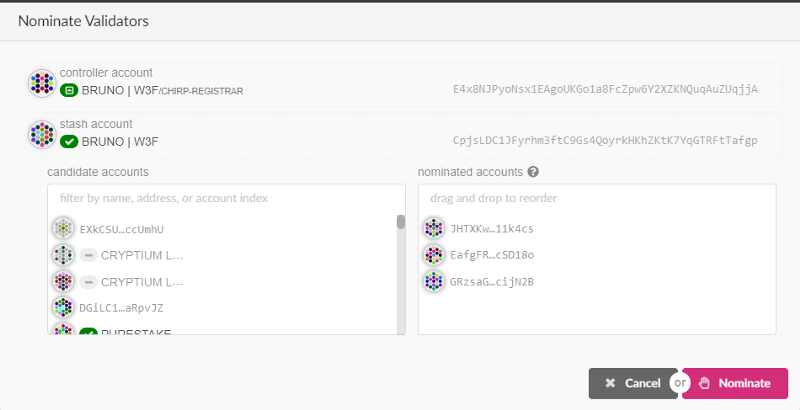Hi Readers👩💻,
In today’s article, we’ll tell you all about choosing and nominating a validator to participate in the Polkadot network and get rewarded for staking DOT tokens.
On Polkadot, validators assure security to the network and support the creation of new blocks. Other Decentralized Proof of Stake (DPoS) networks often refers to nomination as a delegation. However, Polkadot prefers the term nomination, which is why we’re sticking with that term in this article.
🧐 A Quick Recap — The Polkadot Network
The Polkadot Network is a global network of interoperable chains, also known as a sharded blockchain. Meaning, it connects multiple chains to create a unified network for blockchain to process in parallel and exchange data with reliable security between chains.
That said, with Polkadot, you can communicate with other existing chains ported on the Polkadot layer. Creating new chains and sending transactions and messages to other users is also possible. In a nutshell, Polkadot empowers a network of blockchains. However, because one chain doesn’t fit all applications in the network, you can have various chains. Each of them adjusted to the problem they’re solving.
Polkadot is set to solve major throughput issues that so far have hindered the decentralization application development. With its design, applications from decentralized finance and energy, to gaming can thrive on the network. It offers heterogeneous sharding, scalability, upgradeability, transparent governance, and cross-chain composability. These are distinct advantages over existing networks.
- 👉 For further information on the ins and outs of the Polkadot network, click here.
🟣 Nominees and Validators
The nominees in the Polkadot ecosystem are passive participants; this means they’re not involved in assuring the health and security of the network. More specifically, nominees have two tasks: choosing a responsible validator and adding their share of tokens. By appointing their stake, they can elect the active set of validators and share the rewards that are paid out.
Being a nominator doesn’t require running a node of your own or concerning yourself with online uptime. However, nominators are expected to perform due diligence on the validators that they elect. Furthermore, when looking for validators to nominate, a nominator needs to pay attention to their reward percentage and risk that they bare of being slashed if the validator gets slashed.
A validator is a staking provider, like Staking, and is an active member of the network. They distribute rewards among the nominees, who in turn, get their digital assets by voting for their chosen validator.
💻 Polkadot UI To Nominate
The easiest way to nominate is through the Polkadot UI. Open the “Staking” tab in the UI (see image below). The “Staking Overview” shows all the active validators and the amount of DOTs that are staking for them, their own provided stake, commission charges, the era points they’ve earned, and the last block number that they produced.
- Era points refer to a period (24 hours in Polkadot) for which validators are paid proportionally to the number of points they’ve collected. Era points are reward points earned for payable actions.
The “Validator Stats” will show you more detailed and historical information about the validator stake, rewards, and slashes.

Other subsections are:
- Account actions — allowing you to stake and nominate
- Payouts — will enable you to claim your rewards for staking.
- Targets — help you estimate your earnings.
- Waiting — this section lists all pending validators waiting for more nominations to enter the current validator set. Validators stay in the queue until they have enough DOT backing them.
Before you can nominate a validator, you have to bond your DOTs. Select “account actions” and then select the Nominator button. Second, pick a “value bonded” less than the amount of DOTs you own, so you leave some for transaction fees. Transactions fees are currently 0.01 DOT, but as they are dynamic, it is essential to keep some as a back-up.
Moreover, you have to be aware of the reaping threshold. That is the amount that should remain in an account (0.01 DOT), so that the account does not get burned: so that it is not deleted from the blockchain. Select the wallet you want to send your DOTs to.

Now, it’s time to nominate a validator. Your assets are now locked and could be slashed in case the validator you have nominated misbehaves. You can select up to 16 different validators to distribute your assets to.
Select “Nominate” on an account that is bonded. A pop-up will ask you to select your validators (see image below). Select the validators, confirm your transaction — and you’re done!

It is important to remember that your nominates will become active in the next era (period), which lasts 24 hours on Polkadot. On the “Staking” tab, you can check how far along the current era of Polkadot is. You will start getting rewards allocated to you if your nominations end up in the active validator set.
If you’d like to claim your rewards, you have to do so manually. The “Staking Payout” page on Polkadot UI, will show you the list of validators that you have nominated in the last 84 eras. Each of those has the option to trigger the payout for all unclaimed eras; this will pay everyone who has nominated that validator during the eras.
Update:
14Uu59k5VLBz3zLMaEe3LBcqRLfKw2VJu2D3krxTssREjDJc
Additionally, you can find “Stakin” validators by searching for us in the Polkadot UI. Stakin-1 validator is supported by the Foundation as part of the 1,000 Validator Program and will be running with only 3% fees.
📖 More Information & Sources
- Polkadot Official Website
- Polkadot Wiki
- Polkadot Twitter
- Polkadot UI
- Staking Official Website
- Staking Twitter
DISCLAIMER: This is not financial advice. Staking, delegation, and cryptocurrencies involve a high degree of risk, and there is always the possibility of loss, including the loss of all staked digital assets. Additionally, delegators are at risk of slashing in case of security or liveness faults on some protocols. We advise you to do your due diligence before choosing a validator.



